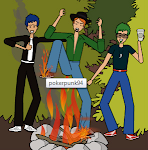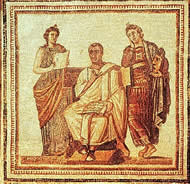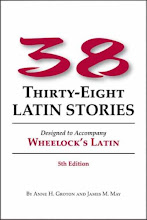~~~ Active Passive
Present Am hitting/hits Is hit
Future Shall hit Shall be hit
Imperfect Was hitting Was hit
Perfect Has hit Has been hit
Future Perfect Will have hit Will have been hit
Pluperfect Had hit Had been hit
Website of the Gods!!!
This is a blog of the gods, Ancient Rome, the Gallic Wars, translations, and other Latiny stuff!
Thursday, December 31, 2009
Wednesday, December 30, 2009
Virgil's 4th Eclogue Parsing-Review for Mid-Term
Verb Parsing
- Incipit-3rd person singular present active indicative of "incipere" meaning "to begin"
- Erunt-3rd person plural future active indicative of "esse" meaning "to be"
- Venit-3rd person singular present active indicative of "venire" meaning "to come"
- Liberabitur-3rd person singular future passive indicative of "liberare" meaning "to free"
- Videbit-3rd person singular future active indicative of "videre" meaning "to see"
- Videbitur-3rd person singular future passive indicative of "videre" meaning "to seem"
- Reget-3rd person singular future active indicative of "regere" meaning "to direct"
- Feret-3rd person singular future active indicative of "ferre" meaning "to bring"
- Poterit-3rd person singular future active indicative of "posse" meaning "to be able to"
- Parabunt-3rd person plural future active indicative of "parare" meaning "to prepare"
Tuesday, December 29, 2009
CH 27 SA Review
- It draws my new strength: I see more clearly, but I make so much worse and I do not know why.
- Certain songs are good; many are bad.
- He is the best. Nothing is better, I have seen nothing more beautiful than this.
- I hope you and this man's birthday and most others are about to drive with happiness.
- Since planning and reckoning are in old age, our ancestors called the senate our highest council.
- More effort and zeal should be put in domestic matters by us even in military matters.
- Neither was the danger graver in the republic, nor the laziness greater.
- We are wiser than those men, because we know nature is the best leader.
- Nature asks very little, but a wise man accommodates himself to nature.
- The greatest remedy for anger is delay.
- Which spirits he conquers and anger he contains I do not compare, but I say he is like a god.
- Dionysus, a tyrant of a most beautiful city, was a man of great temperance in his ways of life, and in all things was diligent and sharp. He too was fierce and unjust. Out of this affair, if we speak the truth, he seemed very wretched.
- If I cannot turn the gods, I shall disturb Acheron.
Monday, December 28, 2009
Spartacus-Who
Spartacus was the most notable leader of the slaves in the Third Servile War. He led a major uprising against the Roman Republic. Spartacus' struggle was a fight against oppression for freedom. Spartacus was a brilliant tactician, and was winning against Rome, so more and people flocked to him. Crassus was given the charge of quelling the revolt. Spartacus died fighting Crassus, who had driven him south with the Roman Legions and defeated him.
Picture: http://www.s9.com/images/portraits/28569_Spartacus.jpg
Picture: http://www.s9.com/images/portraits/28569_Spartacus.jpg
Friday, December 25, 2009
Interesting Fact of Rome (7)
31. in 695, Leontius, the leader of the rebellious Constantinipolitans, seized emperor Justinian II and had his nose cut off, in the belief that Justinian II would not try for the throne again. three years later, Leontius was overthrown by General Tiberius, who had Leontius' nose cut off. Seven years after that, Justinian II retook the throne and had Leontius and Tiberius publicly humiliated and executed.
32. In the ninth century, Vikings were raiding Constantinople at the mouth of the Black Sea.
33. in 1014, Emperor Basil II wished to end the 40 year long war with the Bulgarians. He blinded all but 150 out of 15,00 prisoners, the 150 were blinded in only one eye, and sent them home with a one-eyed leader to Ohrid, whose ruler Samuel, had received word that his army was returning. He rushed to meet them, and at the sight of his thousands of blind men, Samuel suffered a stroke and died. Basil II received the title Baroktonis, meaning "slayer of Bulgarians."
P.S. Merry Christmas!!!
Picture: http://static-p4.fotolia.com/jpg/00/05/69/83/400_F_5698347_3m9W3rquzoXyQmXvcLul4SI7mLYbSV6M.jpg
32. In the ninth century, Vikings were raiding Constantinople at the mouth of the Black Sea.
33. in 1014, Emperor Basil II wished to end the 40 year long war with the Bulgarians. He blinded all but 150 out of 15,00 prisoners, the 150 were blinded in only one eye, and sent them home with a one-eyed leader to Ohrid, whose ruler Samuel, had received word that his army was returning. He rushed to meet them, and at the sight of his thousands of blind men, Samuel suffered a stroke and died. Basil II received the title Baroktonis, meaning "slayer of Bulgarians."
P.S. Merry Christmas!!!
Picture: http://static-p4.fotolia.com/jpg/00/05/69/83/400_F_5698347_3m9W3rquzoXyQmXvcLul4SI7mLYbSV6M.jpg
Thursday, December 24, 2009
Interesting Facts of Rome (6)
26. The plague that swept through much of the civilized world in 542-543 AD was said by Procopius to have killed 10,000 people daily in Constantinople at its height. Emperor Justinian caught the plague but recovered.
27. In 554, Narses destroyed the Ostrogoths and took back Roman control of Italy. He was 90 years old.
28. Emperor Justinian bribed two Persian monks to take silkworm eggs and bring them back to Constantinople. Silk production began in 550 AD.
29. Since 5622, the Hagia Sophia cathedral at Constantinople has held the largest self-supporting dome, in an acting seismic region.
30. An authentic "lost weapon" is Greek fire, used in Constantinople against the Muslims in the seventh and ninth centuries.
Picture: http://static-p4.fotolia.com/jpg/00/05/69/83/400_F_5698347_3m9W3rquzoXyQmXvcLul4SI7mLYbSV6M.jpg
27. In 554, Narses destroyed the Ostrogoths and took back Roman control of Italy. He was 90 years old.
28. Emperor Justinian bribed two Persian monks to take silkworm eggs and bring them back to Constantinople. Silk production began in 550 AD.
29. Since 5622, the Hagia Sophia cathedral at Constantinople has held the largest self-supporting dome, in an acting seismic region.
30. An authentic "lost weapon" is Greek fire, used in Constantinople against the Muslims in the seventh and ninth centuries.
Picture: http://static-p4.fotolia.com/jpg/00/05/69/83/400_F_5698347_3m9W3rquzoXyQmXvcLul4SI7mLYbSV6M.jpg
Wednesday, December 23, 2009
Interesting Facts of Rome (5)
21. Cyprus was an important mining center, but for unknown reasons, was shut down by the Romans. Later in the 20th century, an American rediscovered them, and Cyprus is important in mining again.
22. The Byzantines never called themselves the Byzantines, the name came from Byzantium, the former name of the city Constantinople.
23. The Roman Empire and Persia signed "the Endless Peace" treaty in 533, and were at war seven years later.
24. In 534, Dennis the Little created the system of counting years still used today by starting with the birth of Christ.
25. In 537, Emperor Jutsinian held a banquet for which 6,000 sheep, 1,000 oxen, 1,000 pigs, 1,000 chickens, and 500 deer were slaughtered.
Picture: http://static-p4.fotolia.com/jpg/00/05/69/83/400_F_5698347_3m9W3rquzoXyQmXvcLul4SI7mLYbSV6M.jpg
22. The Byzantines never called themselves the Byzantines, the name came from Byzantium, the former name of the city Constantinople.
23. The Roman Empire and Persia signed "the Endless Peace" treaty in 533, and were at war seven years later.
24. In 534, Dennis the Little created the system of counting years still used today by starting with the birth of Christ.
25. In 537, Emperor Jutsinian held a banquet for which 6,000 sheep, 1,000 oxen, 1,000 pigs, 1,000 chickens, and 500 deer were slaughtered.
Picture: http://static-p4.fotolia.com/jpg/00/05/69/83/400_F_5698347_3m9W3rquzoXyQmXvcLul4SI7mLYbSV6M.jpg
Tuesday, December 22, 2009
Interesting Facts of Rome (4)
16. When the Roman Empire "fell" in the fifth century, it was only the Eastern half of the continent.
17. The Italian city Ravenna was on the coast of the Adriatic. Honorius made this city the capital of the Western Roman Empire.
18. Roman Emperor Theosdosius built a triple wall from the Golden Horn to the Sea of Marmara.
19. The word "mile" comes form the Roman milia meaning "thousands."
20. The Romans used poisonous led as a sweetening agent.
Picture:http://static-p4.fotolia.com/jpg/00/05/69/83/400_F_5698347_3m9W3rquzoXyQmXvcLul4SI7mLYbSV6M.jpg
17. The Italian city Ravenna was on the coast of the Adriatic. Honorius made this city the capital of the Western Roman Empire.
18. Roman Emperor Theosdosius built a triple wall from the Golden Horn to the Sea of Marmara.
19. The word "mile" comes form the Roman milia meaning "thousands."
20. The Romans used poisonous led as a sweetening agent.
Picture:http://static-p4.fotolia.com/jpg/00/05/69/83/400_F_5698347_3m9W3rquzoXyQmXvcLul4SI7mLYbSV6M.jpg
Monday, December 21, 2009
Interesting Facts of Rome (3)
11. When the Romans built Hadrian's wall, they included a moat inside and outside the wall. The purpose of this, is to be determined, but soon after the wall was built, the Romans filled the inner moat in.
12. Emperor Commodus fought and won 11 battles in the gladiatorial arena.
13. One of the worst Roman emperors was Heliogabulus. He replaced the gods of Syrian Gods.
14. Dependence on slave labor was one of the downfalls of the Roman Empire.
15. In the fourth century, twenty great families in six large clans owned most of the land in Gaul
Picture: http://static-p4.fotolia.com/jpg/00/05/69/83/400_F_5698347_3m9W3rquzoXyQmXvcLul4SI7mLYbSV6M.jpg
12. Emperor Commodus fought and won 11 battles in the gladiatorial arena.
13. One of the worst Roman emperors was Heliogabulus. He replaced the gods of Syrian Gods.
14. Dependence on slave labor was one of the downfalls of the Roman Empire.
15. In the fourth century, twenty great families in six large clans owned most of the land in Gaul
Picture: http://static-p4.fotolia.com/jpg/00/05/69/83/400_F_5698347_3m9W3rquzoXyQmXvcLul4SI7mLYbSV6M.jpg
Friday, December 18, 2009
Interesting Facts of Rome (2)
6. Emperor Nero's last words were "Qualis artifex pereo", meaning "what an artist dies within me."
7. In the first hundred days of the Colosseum in Rome in 80 AD, over 5,000 animals were killed, including: elephants, tigers, lions, elks, hyenas, hippopotamuses, and giraffes.
8. The amount of people able to fit in the Colosseum is to be debated, but 45,000 is generally the accepted figure.
9. At the peak of the Roman Empire, the size of Rome was about the size that the US is now.
10. The empire was know together by 18,000 of roads.
Picture: http://static-p4.fotolia.com/jpg/00/05/69/83/400_F_
5698347_3m9W3rquzoXyQmXvcLul4SI7mLYbSV6M.jpg
7. In the first hundred days of the Colosseum in Rome in 80 AD, over 5,000 animals were killed, including: elephants, tigers, lions, elks, hyenas, hippopotamuses, and giraffes.
8. The amount of people able to fit in the Colosseum is to be debated, but 45,000 is generally the accepted figure.
9. At the peak of the Roman Empire, the size of Rome was about the size that the US is now.
10. The empire was know together by 18,000 of roads.
Picture: http://static-p4.fotolia.com/jpg/00/05/69/83/400_F_
5698347_3m9W3rquzoXyQmXvcLul4SI7mLYbSV6M.jpg
Thursday, December 17, 2009
Interesting Facts of Rome (1)
1. After its rebuilding by Caesar, the Circus Maximus housed 250,000 people.
2. Virgil's quest for perfection almost lead posterity not to inherit the Aeneid, as he did not wish for it to be published, but burned, as it was "not polished." Augustus stepped in and countermanded this request, and published the Aenied.
3. Gauis Caesar was so hated he was killed by one of his own gaurds.
4. Caligula had a favorite horse with a golden goblet for wine.
5. The first volume of recipes was first published in 62 AD by Apicius. It was titled De Re Coquinaria.
Picture: http://static-p4.fotolia.com/jpg/00/05/69/83/400_F_5698347_3m9W3rquzoXyQmXvcLul4SI7mLYbSV6M.jpg
2. Virgil's quest for perfection almost lead posterity not to inherit the Aeneid, as he did not wish for it to be published, but burned, as it was "not polished." Augustus stepped in and countermanded this request, and published the Aenied.
3. Gauis Caesar was so hated he was killed by one of his own gaurds.
4. Caligula had a favorite horse with a golden goblet for wine.
5. The first volume of recipes was first published in 62 AD by Apicius. It was titled De Re Coquinaria.
Picture: http://static-p4.fotolia.com/jpg/00/05/69/83/400_F_5698347_3m9W3rquzoXyQmXvcLul4SI7mLYbSV6M.jpg
Wednesday, December 16, 2009
When in Rome-When
"When in Rome, do as the Romans do"
Many often hear this phrase, but what does it really mean? The statement mean that when in new environments, try to follow the customs and traditions of the area, often used when speaking of heading to foreign countries. This is to avoid conflict that could arise from not knowing the culture. A popular story thought to hold the key to this mystery, is that when St. Augustine asked St. Ambrose to go on a mission to Rome, he didn't know what holy day to follow to fast, as Romans held it on a different day. St. Augustine wisely told Ambrose, "When in Rome, do as the Romans do."
Picture: http://i.dailymail.co.uk/i/pix/2008/04/28/article-1017063-0101159700000578-232_468x395.jpg
Tuesday, December 15, 2009
Hippocampi-What
The hippocampus is the mythological creature shared by Greek and Phoenician mythology, though the name is purely Greek, meaning "horse" and "monster." It is often called a sea-horse in English. Typically the horse is the front part and a coiling, scaly, fish-like tail. The hippocampus became a part of Etruscan mythology, which affects Roman mythology. Neptune often drives a sea-chariot pulled by hippocampi.
Link: http://www.theoi.com/image/P12.4BThetis.jpg
Link: http://www.theoi.com/image/P12.4BThetis.jpg
Monday, December 14, 2009
SPQR-Who
SPQR is an initialism for the Latin phrase "the Senate and People of Rome." It refers to the government of the ancient Roman Republic. It was used as the official signature of the government. It appears on coins, documents made public by inscription in stone or metal, in dedications of monuments and public works, and was emblazoned on the standards of the Roman Legions. The phrase also appears many times in Roman literature.
Link: http://www.novaroma.org/vici/images/thumb/400px-Spqr-big-trans.gif
Link: http://www.novaroma.org/vici/images/thumb/400px-Spqr-big-trans.gif
Friday, December 11, 2009
Titans-What
 The Titans were: Kronos, Koios, Krios, Hyperion, Iapetos, Okeanos, Ouranos, and Gaia. They ruled the cosmos before the Olympians came to power. Hyperion, Koios, Krios, and Iapetos were all posted at the 4 corners of the world, and the Cyclopes and Hekatonkheires were placed in the pit of Tartaros.
The Titans were: Kronos, Koios, Krios, Hyperion, Iapetos, Okeanos, Ouranos, and Gaia. They ruled the cosmos before the Olympians came to power. Hyperion, Koios, Krios, and Iapetos were all posted at the 4 corners of the world, and the Cyclopes and Hekatonkheires were placed in the pit of Tartaros.A prophecy was told that Kronos' children would overthrow him. Therefore, he ate all of his children as soon as they were born. When Zeus was born, Rhea gave to Kronos, the Titan-king, a rock to eat instead. When Zeus grew up he made Kronos disgorge his siblings, who, being immortal, were still alive. The gods then overthrew the Titans.
 Pictures: http://www.fashion-res.com/EX/10-08-03/The%2520Battle%2520Betwee
Pictures: http://www.fashion-res.com/EX/10-08-03/The%2520Battle%2520Between%2520the%2520Gods%2520a
nd%2520the%2520Titans.jpg
-http://www.theoi.com/Titan/
Titanes.html
Thursday, December 10, 2009
Latin (FAIL) Review for Mid-term *cough fail cough*
A.
ID and translate each Ablative Absolute and Passive Periphrastic-> Sententiae Antiquae-> page159
1. Carthago delenda est-Passive Periphrastic
2. Asia victa-Ablative Absolute
3. Omnibus ferro militis perterritis-Ablative Absolute
4. Quidquid dicendum est-Ablative Absolute
5. Sananda sunt-Passive Periphrastic
6. Augusto terras tenente-Ablative Absolute
7. Tarquinio expulso-Ablative Absolute
8. Regenda sunt-Passive Periphrastic
B.
ID and Parse each participle-> Sententiae Antiquae-> page 152-> ex. laudans-present active participle
1. Oppressus- future passive participle
2. Tendentes-present passive participle
3. Sitiens-present active participle
4. Fugientia-present active participle
5. Futurarum-future active participle
6. Capta-perfect passive participle
7. Fugienti-present active participle
8. Educandum-future passive participle
9. Scripturus-future active participle
10. Dicturi-future active participle
11. Audituros-future active participle
12. Legens-present active participle
13. Factorum-future active participle
14. Timens-present active participle
15. Iussus-perfect passive participle
16. Emissum-perfect passive participle
C.
ID the verbs that introduce the indirect statements-> Sententiae Antiquae-> pages 167-168
1. Negavit
2. Pronuntiatis, scivisti
3. Sentis
4. Vidi
5. Cerno
6. Credo
7. Sciebam
8. Nuntiavit
9. Dico
10. Vidisse
11. Putabat
12. Negant
13. Negavi
14. Credo
15. Dicere
16. Aiunt
D.
ID and translate jussives-> Sententiae Antiquae-> page 191
1. Ducat-let it command
2. Cedant-let them concede
5. Rapiamus-
ID and translate each Ablative Absolute and Passive Periphrastic-> Sententiae Antiquae-> page159
1. Carthago delenda est-Passive Periphrastic
2. Asia victa-Ablative Absolute
3. Omnibus ferro militis perterritis-Ablative Absolute
4. Quidquid dicendum est-Ablative Absolute
5. Sananda sunt-Passive Periphrastic
6. Augusto terras tenente-Ablative Absolute
7. Tarquinio expulso-Ablative Absolute
8. Regenda sunt-Passive Periphrastic
B.
ID and Parse each participle-> Sententiae Antiquae-> page 152-> ex. laudans-present active participle
1. Oppressus- future passive participle
2. Tendentes-present passive participle
3. Sitiens-present active participle
4. Fugientia-present active participle
5. Futurarum-future active participle
6. Capta-perfect passive participle
7. Fugienti-present active participle
8. Educandum-future passive participle
9. Scripturus-future active participle
10. Dicturi-future active participle
11. Audituros-future active participle
12. Legens-present active participle
13. Factorum-future active participle
14. Timens-present active participle
15. Iussus-perfect passive participle
16. Emissum-perfect passive participle
C.
ID the verbs that introduce the indirect statements-> Sententiae Antiquae-> pages 167-168
1. Negavit
2. Pronuntiatis, scivisti
3. Sentis
4. Vidi
5. Cerno
6. Credo
7. Sciebam
8. Nuntiavit
9. Dico
10. Vidisse
11. Putabat
12. Negant
13. Negavi
14. Credo
15. Dicere
16. Aiunt
D.
ID and translate jussives-> Sententiae Antiquae-> page 191
1. Ducat-let it command
2. Cedant-let them concede
5. Rapiamus-
Wednesday, December 9, 2009
Temple of Peace-Where
The Temple of Peace (AKA Forum of Peace) was built by Vespasian. It was built with the spoils of the Jewish War after the fall of Jerusalem in 71 AD. The temple was dedicated in 75 AD, and it was one of the most impressive monuments in the city. It was located north of the Basilica Aemilia that was in an area of the city that hadn't recovered from the great fire of 64 AD. The forum included a plaza with garden, a temple, and a library, within which were placed many of the treasures from Jerusalem. Vespasian brought multitudes of important works of art from all of Rome to the temple. He made the collection available for the enjoyment of the public.
Picture: http://intranet.arc.miami.edu/rjohn/images/RomeFora/Vespacian%20with%20Temple%20of%20Peace.jpg
Picture: http://intranet.arc.miami.edu/rjohn/images/RomeFora/Vespacian%20with%20Temple%20of%20Peace.jpg
Tuesday, December 8, 2009
79 AD-When
Mount Vesuvius erupted in 79 AD. The long, catastrophic eruption lasted 2 days. Pompeii was buried under 60 ft of ash and pumice. Herculaneum, its sister city, was also destroyed and completely buried. Pompeii was lost for almost 1,700 years, until is was accidentally discovered in 1748. Pompeii is now a ruined and partially buried town-city near Naples, in Campania, in the comune of Pompei (sic). It now provides insight into the life of a city at the height of the Roman Empire.
Picture: http://www.dogsofpompeii.com/images/pompeii_temple_of_jupiter.jpg
Picture: http://www.dogsofpompeii.com/images/pompeii_temple_of_jupiter.jpg
Monday, December 7, 2009
Ambigrams-What
An ambigram is a typographical design that may be read as one or more words not only in the form presented, but from a different viewpoint, direction, or orientation.The words could be the same or different from the original words. All of the above ambigrams are rotational ambigrams, meaning if you turn them 180 degrees, you see the same word again. "Ambire" in Latin means "to go round, visit in rotation, inspect, circle"
For an ambigram generator, check out: http://www.flipscript.com/ambigram-generator.aspx
For an ambigram generator, check out: http://www.flipscript.com/ambigram-generator.aspx
Sunday, December 6, 2009
Why Did Pygmies Fight Cranes?
Pygmies were an African tribe who lived on the southern shores of the great, earth encircling river. They were engaged in eternal war with flocks of migrating cranes. Pygmies were short, dark-skinned men who grew to be the foot of one pygmy. Pygmy was a unit of measure from the length of a man's elbow to knuckle bone (about 1 and 1//2 ft). The pygmies lived in India and sub-Saharan Africa
Picture: http://www.theoi.com/Phylos/Pygmaioi.html
Picture: http://www.theoi.com/Phylos/Pygmaioi.html
Thursday, December 3, 2009
Domus Augustana-Where
The Domus Augustana was the principal residence of the emperors in Rome from the late 1st to 3rd centuries AD. It covered an enormous area on the southeastern side of the Palatine. This structure dates to the time of Domitian (AD 51-96). It was designed by his architect, Rabirius. The Domus Augustana sits on massive terraces where the House of Griffins and Nero's Domus Transitoria were buried. The upper level was for public places (ex. reception, banquet halls). The lower level was for the private quarters of the imperial family. It was located inside of the Circus Maximus, the Hippodrome, and the Septizodium.
Picture: http://maquettes-historiques.net/R93.jpg
Picture: http://maquettes-historiques.net/R93.jpg
Wednesday, December 2, 2009
Definition of a Hero

A hero is one who makes a positive difference in someone else's life. This could be in the form of the garden variety superheroes like Superman, Spiderman, Wonder Woman, etc. It could also be one of the great heroes of Greek mythology, like Perseus, Heracles, and Achilles who are eventually deified. Then there are the less known heroes, the person who saves a child from a life of crime and redirects him towards good, or the person in the bank during the robbery who takes down the robber before he strikes, or all the policemen/policewomen and firefighters from 9/11, or the soldiers in Iraq who gave their lives for their country. A hero is one who is selfless for the good of others. Heroes may not always succeed. Maybe the man trying to stop the robber gets shot, but that doesn't make him any less of a hero. The thought and act of self-sacrifice, courage, altruism, and moral good were there.
Heroes are not the ones who score the game-winning touchdown or make the last goal in their soccer game to win it, they are the ordinary people who do extraordinary things. Heroes don't necessarily have to be the big, courageous, strong types either. The person who donates his time and efforts to Manna House, for example, is a hero of his own.
Heros are also not those who do the act of heroism just for the credit. They are those who never want the credit.
A hero is one who does great deeds for the benefit of others. A hero makes a difference.
Picture: http://sojournproject.files.wordpress.com/2009/06/super_hero.jpg
Tuesday, December 1, 2009
Satyrs-What

In Greek mythology, satyrs are deities of woods and mountains. They are half man, half goat. The upper half of the body is human, while the lower half has a goat's tail, flanks, and hooves. Even though the upper part of the body is human, they also have the horns of a goat. Many satyrs are the companions of Dionysus, god of wine. They spend their time drinking, dancing, and chasing nymphs.
Picture:http://www.elfwood.com/art/s/a/sarabean/satyrs.jpg
Subscribe to:
Comments (Atom)





























